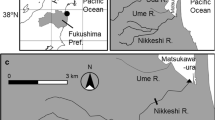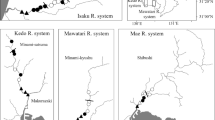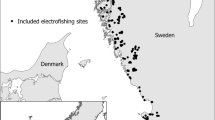Abstract
Freshwater reclaimed marshes along the European Atlantic coast are highly suitable for European eels (Anguilla anguilla). However, European eel stocks have declined, and the coastal marshes have been subjected to major disturbances. The objective of our study was to analyze the processes governing patterns of European eel microhabitat distribution of four eel size classes (from <160 mm to >360 mm) in a reclaimed marsh (France). Analyses were conducted using artificial neural network (ANN) techniques and ecological profiles. Our ANN results showed that eel densities were significantly related to three major influencing variables: the width of ditch section, the silt depth, and the density of emergent plants. Such ecological profiles were significantly different between small (<240 mm) and large eels (>360 mm): small eels were more widespread than large eels. Large eels were absent or at low densities in shallow ditches with a high aquatic plant cover obstructing the water column and a large quantity of silt. These characteristics seem to define the ditches not directly connected with the main river where dredging operations were rare. Management of regular dredging operations in the channels by maintaining a mosaic of permanent aquatic habitats and avoiding the heavy silt loads in most ditches should be promoted. This dredging operation was probably one of the most promising ways for restoring inland eel stocks.
Similar content being viewed by others
literature cited
Adam, G. 1997. L’anguille européenne (Anguilla anguilla L. 1758): dynamique de la sous-population du lac de Grand-Lieu en relation avec les facteurs environnementaux et anthropiques. Ph. D. Dissertation. University of Toulouse 3, France.
Ardizzone, G. D. and F. Corsi. 1985. Eel population structure, dynamics and fishing yield in a Mediterranean coastal lagoon. Oebelia 11:547–560.
Baisez, A. 2001. Optimisation des suivis des indices d’abondances et des structures de taille de l’anguille européenne (Anguilla anguilla, L.) dans un marais endigué de la côte atlantique: relations espèce—habitat. Ph. D. Dissertation. University of Toulouse 3, France.
Baisez, A., C. Rigaud, and E. Feunteun. 2000. Hétérogénéité de répartition de l’anguille européenne (Anguilla anguilla, L.) observée par pêche électrique dans un marais endigué de la côte atlantique française (Marais breton). Cybium 24:23–32.
Beecher, H. A., T. H. Johnson, and J. P. Carleton. 1993. Predicting microdistributions of steehead (Oncorhynchus mykiss) parr from depth and velocity preference criteria: test of an assumption of the instream flow incremental methodology. Canadian Journal of Fisheries and Aquatic Sciences 50:1380–1387.
Beja, P. R. 1996. Seasonal breeding and food resources of otters, Lutra lutra (Carnivora, Mustelidae), in South-West Portugal: a comparison between coastal and inland habitats. Mammalia 60: 27–34.
Broad, T. L., C. R. Townsend, C. J. Arbuckle, and D. J. Jellyman. 2001. A model to predict the presence of longfin eels in some New Zealand streams, with particular reference to riparian vegetation and elevation. Journal of Fish Biology 58:1098–1112.
Brosse, S., P. Laffaille, S. Gabas, and S. Lek. 2001. Is scuba sampling a relevant method to study fish microhabitat in lakes? Examples and comparisons for three European species. Ecology of Freshwater Fish 10:138–146.
Butet, A. and A. B. Leroux. 2001. Effects of agriculture development on vole dynamics and conservation of Montagu’s harrier in western French wetlands. Biological Conservation 100:289–295.
Carle, F. L. and M. R. Strub. 1978. A new method for estimating population size from removal data. Biometrics 35:621–630.
Chisnall, B. L. 1996. Habitat associations of juvenile shortfinned eels (Anguilla australis) in shallow lake Waahi, New Zealand. New Zealand Journal of Marine and Freshwater Research 30:233–237.
Chisnall, B. L. and B. J. Hicks. 1993. Age and growth of longfinned eels (Anguilla dieffenbachii) in pastoral and forested streams in the Waikato river basin and in two hydro-electric lakes in the North island, New Zealand. New Zealand Journal of Marine and Freshwater Research 27:317–332.
Colasanti, R. L. 1991. Discussions of the possible use of neural network algorithms in ecological modelling. Binary 3:13–15.
Cowx, I. G. 1983. Review of the methods for estimating fish population size from survey removal data. Fisheries Management 14: 67–82.
Dekker, W. 2000. A Procrustean assessment of the European eel stock. ICES Journal of Marine Science 57:938–947.
Dimopoulos, I., J. Chronopoulos, A. Chronopouls-Sereli, and S. Lek. 1999. Neural networks models to study relationship between lead concentration in grasses and permanent urban descriptors in Athens city (Greece). Ecological Modelling 120:157–165.
Efron, B. 1983. Estimating the error rate of a prediction rule: some improvements on cross-validation. Journal of the American Statistical Association 78:316–331.
Eybert, M.-C., J. Y. Bernard, P. Constant, E. Feunteun, J. Hedin, and S. Questiau. 1998. Réhabilitation des prairies inondables dans les marais Briérons: évolution de la flore, des poissons et des oiseaux. Gibier Faune Sauvage 15:999–1016.
Feunteun, E. 1994. Le peuplement piscicole du marais littoral endigué de Bourgneuf-Machecoul (France, Loire-Atlantique). Approche méthodologique pour une analyse quantitative de la distribution spatiale du peuplement piscicole et de la dynamique de certaines de ses populations. Ph. D. Dissertation. University of Rennes 1, France.
Feunteun, E. 2002. Management and restoration of the European eel population (Anguilla anguilla): an impossible bargain? Ecological Engineer 18:575–591.
Feunteun, E., A. Acou, J. Guillouët, P. Laffaille, and A. Legault. 1998. Spatial distribution of an eel population (Anguilla anguilla L.) in a small coastal catchment of Northern Brittany (France). Consequences of hydraulic works. Bulletin Français de la Pêche et de la Pisciculture 349:129–139.
Feunteun, E., A. Acou, P. Laffaille, and A. Legault. 2000. The European eel: prediction of spawner escapement from continental population parameters. Canadian Journal of Fisheries and Aquatic Sciences 57:1627–1635.
Feunteun, E., C. Rigaud, and P. Elie. 1992. Le marais doux endigué de Bourgneuf-Machecoul: premiers éléments de connaissance du peuplement piscicole, relation ichthyofaune habitat, mise en évidence des problèmes majeurs de gestion. Revue des Sciences de l’Eau 5:509–527.
Feunteun, E. and L. Marion. 1994. Impact of heron (Ardea cinerea) on fish communities: the case study of the main European colony. Hydrobiologia 279/280:327–344.
Feunteun, E., C. Rigaud, P. Elie, and J.-C. Lefeuvre. 1999. Les peuplements piscicoles des marais littoraux endigués atlantiques: un patrimoine à gérer? Le cas du marais de Bourgneuf Machecoul (Loire-Atlantique, France). Bulletin Français de la Pêche et de la Pisciculture 352:63–79.
Ford, T. E. and E. Mercer. 1986. Density, size distribution and home range of American eels, Anguilla rostrata, in a Massachusetts salt marshes. Environmental Biology of Fishes 17:309–314.
Fustec, E. and J.-C. Lefeuvre (eds.). 2000. Fonctions et valeurs des zones humides, Dunod, Paris.
Gevrey, M., I. Dimopoulos, and S. Lek. 2003. Review and comparison of methods to study the contribution of variables in artificial neural networks models. Ecological Modelling 160:249–264.
Giske, J., G. Huse, and O. Fiksen. 1998. Modelling spatial dynamics of fish. Reviews in Fish Biology and Fisheries 8:57–97.
Glova, G. J. 1988. Fish density variations in the braided Ashley River, Canterbury, New Zealand. New Zealand Journal of Marine and Freshwater Research 22:9–15.
Glova, G. J., D. J. Jellyman, and M. L. Bonnet. 1998. Factors associated with the distribution and habitat of eels (Anguilla spp.) in three New Zealand lowland streams. New Zealand Journal of Marine and Freshwater Research 32:255–269.
Grossman, G. D., R. E. Ratajczak, M. Crawford, and M. C. Freeman. 1998. Assemblage organization in stream fishes: effects of environmental variation and interspecific interactions. Ecological Monograph 68:395–420.
Guisan, A. and N. E. Zimmermann. 2000. Predictive habitat distribution models in ecology. Ecological Modelling 135:147–186.
Ibbotson, A., J. Smith, P. Scarlett, and M. Aprhamian. 2002. Colonisation of freshwater habitats by the European eel Anguilla anguilla. Freshwater Biology 47:1696–1706.
ICES. 1998. European eel. Extract of the report of the ICES Advisory Committee on Fishery Management. International Council for the Exploration of the Sea, Copenhagen, Denmark.
ICES. 1999. European eel. Extract of the report of the ICES Advisory Committee on Fishery Management. International Council for the Exploration of the Sea, Copenhagen, Denmark.
ICES. 2002. European eel. Extract of the report of the ICES Advisory Committee on Fishery Management. International Council for the Exploration of the Sea, Copenhagen, Denmark.
Ivlev, V. S. 1961. Experimental Ecology of the Feeding of Fishes. Yale University Press, New Haven, CT, USA.
Knights, B., A. Bark, M. Ball, F. Williams, E. Winter, and S. Dunn. 2001. Eel and elver stocks in England and Wales. Status and management options. Environment Agency, UK. R&D Technical Report W248.
Kohavi, R. 1995. A study of the cross-validation and bootstrap for accuracy estimation and model selection. p. 1137–1143. In Proceeding of the Intelligence Joint Conference on Artificial Intelligence, Montreal, Quebec, Canada.
Laffaille, P., S. Brosse, S. Gabas, and S. Lek. 2001. Fish spatial distribution in the littoral zone of Lake Pareloup (France) during summer. Archiv für Hydrobiologie 153:129–144.
Laffaille, P., E. Feunteun, A. Acou, and J.-C. Lefeuvre. 2000b. Role of European eel (Anguilla anguilla L.) in the transfer of organic matter between marine and freshwater systems. Verhandlungen Internationale Vereinigung für Limnologie 27:616–619.
Laffaille, P., E. Feunteun, A. Baisez, T. Robinet, A. Acou, A. Legault, and S. Lek. 2003. Spatial organisation of European eel (Anguilla an anguilla L.) in a small catchment. Ecology of Freshwater Fish 12:254–264.
Laffaille, P., J.-C. Lefeuvre, and E. Feunteun. 2000a. Composition of fish communities in macrotidal salt marshes of the Mont Saint-Michel bay (France). Estuarine, Coastal and Shelf Science 51: 429–438.
Lamarque, P. J., J. Arignon, and C. Gosset. 1978. Comparaison des appareils de pêche à l’électricité EPMC et Héron. Bulletin Français de pêche et de Pisciculture 270:223–236.
Lambert, P., E. Feunteun, and C. Rigaud. 1994. Eel study in freshwater marshes. First analysis of catch probability observed during electric fishing operations. Bulletin Français de la Pêche et de la Pisciculture 335:111–122.
Lamouroux, N., H. Capra, M. Pouilly, and Y. Souchon. 1999. Fish habitat preferences in large streams of southern France. Freshwater Biology 42:673–687.
Lefeuvre, J.-C., P. Laffaille, E. Feunteun, V. Bouchard, and A. Radureau. 2003. Biodiversity in salt marshes: from the patrimonial value to the ecosystem functioning. The case study of the Mont Saint-Michel bay. Comptes Rendus Biologies 326:125–131.
Legault, A. 1994. Etude préliminaire du recrutement fluvial de l’anguille. Bulletin Français de la Pêche et de la Piscicultur 335: 33–42.
Lek, S. and J. F. Guégan. 1999. Artificial neural networks as a tool in ecological modelling, an introduction. Ecological Modelling 120:65–73.
Lobon-Cervia, J., C. G. Utrilla, and P. A. Rincon. 1995. Variations in the population dynamics of the European eel Anguilla anguilla (L.) along the course of a Cantabrian river. Ecology of Freshwater Fish 4:17–27.
Marion, L. and L. Brient. 1998. Wetland effects on water quality: input-output studies of suspended particulate matter, nitrogen (N) and phosphorus (P) in Grand-Lieu, a natural plain lake. Hydrobiologia 373/374:217–235.
Moriarty, C. and W. Dekker (eds.). 1997. Management of European Eel Fisheries. Irish Fishery Bulletin 15.
Naismith, I. A. and B. Knights. 1993. The distribution, density and growth of the European eel, Anguilla anguilla, in the freshwater catchment of the River Thames. Journal of Fish Biology 42:217–226.
Nelva, A., H. Persat, and D. Chessel. 1979. Une nouvelle méthode d’étude des peuplements ichtyologiques dans les grands cours d’eau par échantillonnage ponctuel d’abondance. Comptes Rendus de l’Académie des Sciences III, Life Sciences 289:1295–1298.
Neveu, A. 1981. Density and microdistribution of the various fish species in Lower Nivelle, a small coastal river in Pyrénées Atlantiques. Bulletin Français de la Pêche et de la Pisciculture 280:86–102.
Rigaud, C., J. Massé, A. Dutartre, and V. Merle. 1996. Programme Life/Norspa ‘Baie de Bourgneuf et Marais bretons’. Volet ‘Restauration du réseau secondaire du marais doux’. Report Cemagref, Bordeaux, France.
Rumelhart, D. E., G. E. Hinton, and R. J. Williams. 1986. Learning representations by back-propagation error. Nature 323:533–536.
Simberloff, D. 1998. Flagships, umbrellas, and keystones: is single-species management passé in the landscape area? Biological Conservation 83:247–257.
Smogor, R. A., P. L. Angermeier, and C. K. Gaylord. 1995. Distribution and abundance of American eels in Virginia streams: tests of null models across spatial scales. Transactions of the American Fisheries Society 124:789–803.
Author information
Authors and Affiliations
Corresponding author
Rights and permissions
About this article
Cite this article
Laffaille, P., Baisez, A., Rigaud, C. et al. Habitat preferences of different European eel size classes in a reclaimed marsh: A contribution to species and ecosystem conservation. Wetlands 24, 642–651 (2004). https://doi.org/10.1672/0277-5212(2004)024[0642:HPODEE]2.0.CO;2
Received:
Revised:
Accepted:
Issue Date:
DOI: https://doi.org/10.1672/0277-5212(2004)024[0642:HPODEE]2.0.CO;2




